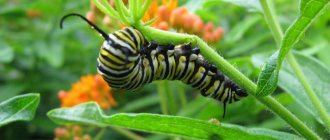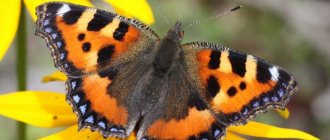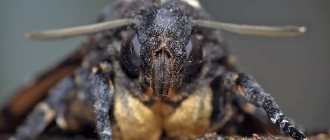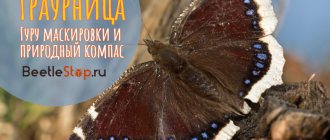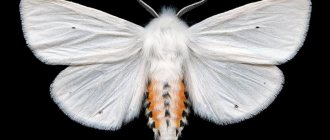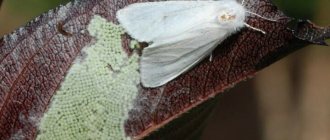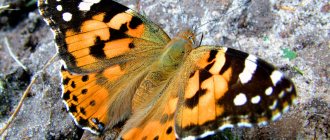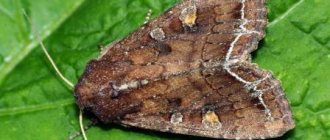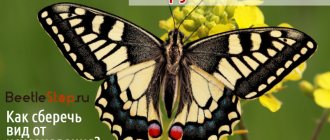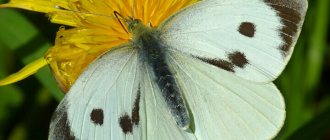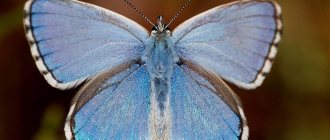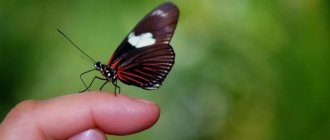- Wild animals
- >>
- Insects
The Zorka butterfly is one of the representatives of the white butterfly family. This species is divided into several subspecies, all of which are considered diurnal. Butterfly has several names. It can be found under the name aurora, short-whiskered whiteweed or core-dawn. The latter name is due to the close connection of the insect with the meadow plant of the same name. She lays eggs on it, caterpillars are born on it and spend some part of their life cycle. The Zorka butterfly is considered one of the most beautiful and fragile among all existing butterflies.
Origin of the species and description
Photo: Dawn butterfly
Aurora belongs to arthropod insects, the order Lepidoptera, and the family of white butterflies. The butterfly is a representative of the subfamily pierinae, genus anthocharis, a species of dawn. The Zorka butterfly has long been considered the embodiment of grace, sophistication and fragility. In ancient Russian myths and tales, the butterfly appears in the image of the goddess of dawn, who brings daylight. Carl Linnaeus was involved in the description of the butterfly, the study of its lifestyle and its cycles.
Paleontologists say that butterflies are among the oldest creatures on earth. The oldest discovery of the ancestors of modern butterflies indicates that they existed approximately 200 million years ago. They appeared much earlier than the most ancient species of flowering plants. According to the discovery, the ancient butterflies resembled moths in appearance. This find made it possible to establish that this type of insect appeared almost 50-70 million years earlier than scientists originally assumed. Initially, ornithologists linked the period of appearance of butterflies to the period of the earth's population with flowering plants, as the main food supply for butterflies.
Video: Butterfly dawn
Another proof that butterflies appeared before flowering plants is the discovery of the scientist and researcher from Germany Van De Schotbrugge. The scientist and his team discovered particles of woody hard rocks in Germany that were about 200 million years old. When studying these rocks, remains of wing scales of ancient primitive butterflies were discovered in them. This species existed on Earth for a short period of time. During the drought period, at the end of the Triassic period, their numbers sharply decreased due to insufficient moisture.
Scientists do not rule out that it was during this period that the ancient ancestors of butterflies formed a proboscis, which made it possible to collect small drops of dew. Subsequently, individuals of this species of butterflies evolved, acquired an appearance similar to modern species and learned to use the proboscis to obtain the main source of food - nectar.
Maliciousness
The vital activity of American white butterfly caterpillars leads to defoliation of plantings, and subsequently to the weakening and death of individual plants. The decorative and protective functions of forest plantations are reduced. In fruit trees, if 20% of the leaves are damaged, the yield decreases by 5-10%, and if 50% of the leaves are damaged, by 50-55%. Eating 75% of foliage results in a complete lack of yield.
The American white butterfly is an incredibly spectacular pest native to North America, from where it later came to Europe. Russia did not escape this fate either - on the territory of this country, the American white butterfly can be found in the western and southern regions. This voracious scoundrel damages more than one hundred and forty varieties of trees and shrubs!
Meet the pest
The smooth, spherical eggs of American white butterflies reach approximately 0.6 - 0.7 mm in size. Most often they are colored bluish, but sometimes they can be yellowish. Light-colored caterpillars of younger ages are endowed with black thoracic legs, thoracic scutes and heads. Along their backs there are two rows of black warts, and on the sides of similar warts the caterpillars have as many as four rows. Each wart is equipped with black and white hairs. The size of caterpillars that have completed feeding reaches up to 30–40 mm in length, and on the sides of their bodies you can see yellow stripes equipped with orange warts. In addition, on each wart you can see thin black and light hairs. And the legs and heads of the caterpillars are painted black. The pupae, growing up to ten to fifteen millimeters in length, are initially lemon-colored, and after some time they become dark brown. Each doll is conveniently located in a fluffy dark cocoon, painted in grayish tones.
Overwintering of pupae takes place under the remains of plants, under dead tree bark, under canopies, in cracks and crevices of fences and in a number of other protected places. In the spring, butterflies do not fly out all at once, but gradually, as a result of which their flight stretches out to a month. The very first butterflies can be seen already at the end of April or at the beginning of May, and their average lifespan ranges from six to fourteen days. All butterflies lead an exclusively crepuscular lifestyle. Fertilized females of American white butterflies lay eggs in groups of three hundred to five hundred pieces, placing them on herbaceous vegetation and on the upper or lower sides of leaves. Caring mothers cover each clutch with a thin transparent fluff. The total fertility of pests is from one thousand two hundred to one and a half thousand eggs, and the embryonic development of their offspring takes from five to ten days.
The development of each caterpillar takes from forty-five to fifty-four days. And during this period they molt six to seven times! Pupation of pests takes place in various protected places. The development of pupae takes from nine to fourteen days, and already in August you can observe the emergence of butterflies of the second generation, the females of which already lay from two thousand to two thousand three hundred eggs.
How to fight
And if after bud break about 20% of the leaves are damaged, then immediately begin treating the trees with insecticides or biological products.
Recorded in Europe (Yugoslavia), where it spread from France to the Caspian Sea. In 1952 it was discovered in the Transcarpathian region of Ukraine. In 1966 it was discovered in the Odessa region and in Moldova, in 1968 - in the Donetsk and Vinnitsa regions. Currently, it has spread to 11 regions of Ukraine, including Kherson, Kyiv, Nikolaev, Zaporozhye, Crimea, etc.
The species was also recorded only once in Lithuania. In 2012, it was discovered in three regions of Ukraine: Vinnitsa, Zhytomyr and Dnepropetrovsk.
Appearance and features
Photo: Butterfly Aurora
Zorka is not very large. She has four wings. The wingspan is small - 48 - 50 mm. The size of the front wing is 23-25 mm. The length of the body of one individual is about 1.7-1.9 cm. The oral apparatus is represented by a proboscis. The head is small in size and has two antennae at the top. The antennae are gray in color, with silver beads located at the end of each of them.
This insect species exhibits sexual dimorphism. Males have yellowish-gray hairs on their head and chest. In females, these hairs are dark gray in color. Also, female and male individuals can be easily distinguished by the color of the wings, in particular their upper part. In males it is white-orange in color, in females it is white. The ends of the wings of females are black, while those of males are white. The inner side of the dawn's wings, regardless of gender, has an unusually rich marble-green color.
Such a bright, saturated color shimmers very interestingly during flight and wingspan. Also, with the help of such bright wings, males attract females during the mating period. At the moment when the butterfly folds its wings, it can easily get lost among various types of vegetation and remain unnoticed.
Interesting fact: The presence of bright orange areas on the wings warns birds of prey that the insect may be poisonous, thereby scaring them away.
The caterpillar that emerges from the cocoon is bluish-green with black speckles. The head part of the body is dark green, almost swamp in color; there is a light stripe in the back area. The pupae have a smooth, streamlined shape, dark green or brown with light stripes on the sides.
The body of butterflies is covered with antennae, the color of which also differs between male and female individuals. In males they are gray with a yellowish tint, in females they are brown. The size of the body and color may vary slightly depending on the region of habitat. The predominant color is white.
Spring
Butterfly
The butterfly woke up and began to circle over the clearing. But everywhere there was only last year’s gray grass. She circled around and, not finding any spring primroses, sat down on a bright orange book left by the children.
Nodules
Buds swelled everywhere on the trees and bushes. They are like knots, like unsolved mysteries. Spring will untie the knots, the sun will straighten and smooth them out, and then from each bud, like a clue, leaves will appear into the light.
High water
Rocks, forests, houses are reflected in the big water... Reflection is like reality, only upside down. Above the earth there are sky and clouds, in the water there are the same sky and clouds. The birds even get confused: they either fly up or rush down, but when they see their reflection, they fly up again. The sky above, the sky below - flood.
Where does the dawn butterfly live?
Photo: Zorka yellow butterfly
Zorka coreta is found mainly in forests, fields, meadows and steppes. They can be found in mountainous areas at altitudes up to 2000 meters above sea level. They like to settle in thickets near water sources. They do not tolerate regions with dry climates well and try to avoid them. Butterflies can fly to city parks and squares.
This type of insect can be found in various parts of Eurasia. They are found almost throughout Europe and in non-tropical regions of Asia. The habitat region extends from the coast of the Barents Sea in the west to the polar Urals in the east. On the territory of the Colm Peninsula, butterflies are associated with anthropogenic meadow biotopes.
Butterflies prefer regions with a subtropical climate, trying to avoid desert areas, as well as regions with arid and extremely dry climates. They like to settle in cleared areas, open forest edges, and meadows with good lighting.
Geographical regions of insect distribution:
- Siberia;
- Transbaikalia;
- Far East;
- China;
- Japan;
- Scotland;
- Scandinavia;
- southern regions of Spain;
- territory throughout Europe.
Interesting fact: There are males who are able to travel quite a long distance in search of food, or females during the breeding season.
They are most common in the spring in Eastern Europe. In the southern regions it appears from mid-March and flies until the end of June, in the northern regions - from the end of April and flies almost until the end of the summer period.
Subspecies
In Eastern Europe and parts of Asia, the main species is Anthocharis cardamines, which has 9 subspecies.
- A.c. koreana – habitats of the Amur and Ussuri rivers;
- A.c. Alexandra – common in Altai;
- A.c. hayashii – territory of Japan;
- A. c. cardamines – Europe, China, temperate Asia;
- A.c. septentrionalis – lives in the Far East;
- A.c. progressa – distribution area of the Tien Shan;
- A. c. phoenissa - lives on the Kopetdag mountain system;
- A.c. isshikii - spread to Sakhalin and Japan;
- A.c. meridionalis – habitat region of Transbaikalia. Sayans.
What does the dawn butterfly eat?
Photo: Zorka butterfly from the Red Book
The main source of nutrition is nectar from flowering plants. They get it using their proboscis. Butterflies prefer to collect pollen from different plants depending on the stage of their life cycle.
Butterflies prefer the following flower plants:
- dog violet flowers;
- primrose;
- oregano inflorescences;
- Evening girls
Caterpillars love to eat:
- lush green vegetation of young shoots;
- meadow core.
The larvae prefer food species of wild cabbage plants:
- spadefoot;
- shepherd's purse;
- rapeseed;
- yarutki;
- reveler;
- mignonette.
The main part of the diet consists of forage species of vegetation. In addition to these types of plants, butterflies love to feast on the pollen and nectar of different types of flowering plants. Zorka coreta is considered an almost omnivorous insect. It should be noted that she consumes quite a large amount of food, despite her very small size.
They tend to gnaw on almost everything that is considered edible for this type of insect. In order for the insect to go through the full cycle of its development, and for the pupa to fully develop, it is necessary to feed intensively. Pollen, nectar and inflorescences of flowering plant species that contain sugar are considered delicacies for butterflies.
Female individuals live and feed throughout their entire life cycle within one region. Males tend to travel long distances in search of food when necessary.
Morphological characteristics of cutworm
Cutworms (Noctuidae).
The head of the moth is round, the forehead is characteristically convex; some individuals, on the contrary, have depressions on the forehead.
In females, the antennae have a simple structure, they are thread-like or comb-like, sometimes they can be framed by fluffy cilia. The structure of the antennae of males is more complex.
Noctuids living in the mountains have elliptical or kidney-shaped eyes. Some species have simple eyes. The proboscis is well developed; in a calm state it is curled. In some species the proboscis is reduced. The surface of the proboscis is covered with “taste cones”.
There are “bloodthirsty” exceptions among cutworms - individuals live in the tropics that feed on the lacrimal glands of mammals and their blood. Only males are bloodthirsty; they have a reinforced proboscis. Females have an undeveloped proboscis, so their diet is more “dietary”; they extract juice from fruits and plants.
Owls are nocturnal moths.
The palps of cutworms can be short or elongated. The head, chest and abdomen are often covered with scales and hairs. In addition, cutworms may have tufts of hairs.
Spurs are often located on the lower legs; other species have claws and spines. The shape of the wings is almost triangular, sometimes it can be elongated, and rarely rounded. Some species of moths have long and narrow wings; such wings allow butterflies to fly long distances. In mountain species, the wings are short, and sometimes they can be completely reduced.
Cutworm butterflies have a body covered with hairs.
The noctuid's body is full and covered with thick hairs. The wings have a pattern of spots; the spots are round, wedge-shaped and kidney-shaped. Some species have silvery and golden spots on their wings. The hind wings can be yellowish, blue, red and white. Noctuid moths, which live in climates with colorful nature, often have distinctive patterns on their wings and bodies.
Features of character and lifestyle
Photo: Dawn butterfly in Russia
The summer period of Zorka serdtnikov is from the end of March, beginning of April to mid-summer. During this period of time, the insect looks for a mate and breeds offspring. This species of butterfly is predominantly diurnal and rests at night. Insects prefer places with plenty of warmth and sunlight. If they end up in regions with a damp, cold or too dry climate, they will most likely die before they can leave offspring. The full development cycle from the egg to the maturation of a full-fledged adult insect lasts approximately about a year.
Interesting fact: During the research, scientists came to the conclusion that the life cycle of the Zorka butterfly can be considered a constant rebirth. A caterpillar emerges from the egg, which turns into a pupa, then into an imago, an adult, and again into an egg. It is noteworthy that a full-fledged adult lives no more than two weeks!
The main phase of the life cycle is called the caterpillar. Since it is during this period that it must accumulate the maximum amount of nutrients necessary for the full development of all other stages of the life cycle. Butterflies of this species are quite peaceful, it is unusual for them to show aggression towards their relatives, they do not compete with each other. This type of insect is not considered harmful, and therefore, even in regions where they are quite common, people do not fight them.
Females tend to settle in a certain territory, males tend to migrate, over rather long distances, and even climb mountains up to 2000 meters above sea level.
Interesting Facts
Orange spots signal to insectivorous birds and other enemies of the dawn that the butterfly is poisonous. The female, which does not have a bright warning color, behaves more secretively and is hardly noticeable in the forbs. Even at the larval stage, the aurora’s body accumulates a substance that irritates the mucous membranes of the respiratory and digestive organs of enemies.
During laying, the female releases a pheromone onto the plant organs to warn other females that the flower is occupied. Rivalry also manifests itself at other stages of development. A strong caterpillar can eat a weak larva if they compete on the same food plant.
Social structure and reproduction
Photo: Aurora butterfly
The breeding season and laying of eggs in the Aurora occurs once a year. When the Aurora’s active summer arrives, each individual begins to look for a suitable mate. Males are the most active in this regard. They persistently take the initiative, courting and flitting about females. Males tend to display bright orange wings, attracting females to choose them for mating.
After mating, the female lays eggs. One female lays from one to three eggs. She first selects a suitable flower for this. This is necessary so that immediately after the larva appears, it can eat plants. During egg laying, a female individual sprays special pheramones on the selected plant, which indicate that this plant is already occupied.
The larva develops over 5-15 days. This period occurs from the end of May to the middle of the first month of summer. The larvae, which have turned into caterpillars, begin to actively eat everything that can be eaten: juicy, green foliage, seeds, flowers, ovaries. The caterpillar has a green color with a blue tint and black dots all over its body. A distinctive feature is also the white line on the back. Over the next 5-6 weeks, molting occurs four times.
The latest generation of caterpillars travel down the plant stem and pupate using a special thread. At the stage of existence in the form of a pupa, the Aurora is extremely vulnerable. The resulting pupa has the shape of a green cone. Subsequently, it darkens and becomes almost brown. In this form, it practically merges with dry vegetation, resembling a thorn or a withered pod. In this form, the aurora waits out the cold winter. If the stem of the plant to which the pupa is attached is damaged or broken, it will certainly die. About 10 months after the formation of the pupa, the imago appears.
Development of the scoop
There is a wide variety of cutworms, so the life cycle of different species varies greatly.
Caterpillars have up to 6 instars, during which up to 5 molts occur. Northern and mountain varieties generally have a two-year life cycle. Pupation of caterpillars occurs in earthen litter, soil or plant tissue. Mostly pupae overwinter, but middle-aged or older caterpillars can also overwinter. In warm areas, cutworms develop continuously, with several generations being formed per year. In winter, they go into a “cold stupor.”
The eggs are hemispherical in shape. The surface of the eggs is cellular or ribbed. Female cutworms lay eggs on the ground. The fertility of females can reach about 2 thousand eggs.
The moth butterfly family has many species.
The caterpillar has a naked body, but it may have primary setae and, in some cases, secondary setae. The body color of the caterpillars is green, yellow or brown. There are longitudinal stripes on the body. Sometimes false legs may be located on the abdominal segment. Noctuid caterpillars are active at night, and during the day they lead a hidden lifestyle. In some species, caterpillars are predators; they additionally feed on scale insects and scale insects.
Natural enemies of the dawn butterfly
Photo: Dawn butterfly
Under natural conditions, butterflies have a large number of enemies. They are extremely vulnerable at almost any stage of their development, in addition to the adult butterfly. This is due to the fact that it is difficult for predators to catch a fluttering insect.
The main natural enemies of the zorka butterfly:
- birds. They are the main and most dangerous enemy of Zorka coredina. At the caterpillar stage, they represent a special delicacy and the main source of food for birds. Zoologists have calculated that it is various species of birds that destroy 25% of butterflies at the egg or larval stage;
- spiders. They pose a serious threat to insects. At the same time, spiders that catch insects through webs pose less of a danger than predator spiders;
- praying mantises;
- flies;
- wasps;
- riders.
Humans play an important role in the status of the species and the number of Aurora individuals. Despite the fact that people do not purposefully take any measures to combat insects, they violate their natural habitat. Changes in the ecological situation and environmental pollution also negatively affect the number of insects.
Admirals in captivity
Surprisingly, admiral butterflies can be kept in captivity. To do this, it needs to emerge from the caterpillar stage so that it can better adapt to new conditions. You need an aquarium without water, but with food plants and a net on top.
There should always be fresh air and high humidity. Vertical branches are also needed so that the young butterfly can spread its wings. The diet consists of fruit juices, honey drinks and fruits.
Photo: avto.goodfon.ru
Population and species status
Photo: Dawn butterfly in nature
Today, ornithologists continue to actively study the vital functions of the Aurora butterfly. Some aspects still remain an unsolved mystery. In this regard, it is not possible to establish the exact number of these insects. The aurora is considered an endangered species only in some regions of Russia and most of the territory of Ukraine. Zorka cored is listed in the Red Book of Ukraine and the Moscow region of the Russian Federation.
This situation is associated with environmental pollution and human development of an increasingly larger part of the territory, thereby causing the death and extermination of insects. The situation is complicated by the fact that the life cycle of a butterfly lasts about a year, and during this period the insect breeds a small number of offspring only once. Considering that at almost every stage of its life cycle the butterfly is very vulnerable, a significant part of the insects is destroyed by natural enemies before they transform into an adult, sexually mature individual.
In addition to all the above factors, the population size is influenced by fungi, pathogenic bacteria and viruses. All these factors together lead to a reduction in the number of the dawn butterfly.
sources
Individual evidence
- Arnold Spuhler: Butterflies of Europe. Tape 1. Bookstore of the publishing house E. Schweitzerbartsche, Stuttgart 1908, p. 8.
- ↑ Heiko Bellmann: A new guide to space butterflies.
Butterflies, caterpillars and food plants. Franckh-Kosmos, Stuttgart 2003, ISBN 3-440-09330-1, p. 122. - Characteristics/fauna of the Minami Alps National Park.
Ministry of Environment (Japan), accessed November 11, 2022 (English). - ↑ V. Dühring: Butterfly Aurora.
In:
Species portraits of butterflies in Rhineland-Palatinate.
BUND RLP, March 26, 2022, accessed March 27, 2022 (German). - Anthocharis cardamina.
Butterflies-Deutschlands.de, Christian Tolasch, Retrieved November 23, 2006.
literature
- Tom Tolman, Richard Lewington: Butterflies of Europe and North-West Africa.
Franckh-Kosmos Verlags-GmbH & Co, Stuttgart 1998, ISBN 3-440-07573-7. - Hans-Josef Weidemann: Butterflies: observe, identify.
Naturbuch-Verlag Augsburg 1995, ISBN 3-89440-115-X. - Günter Ebert, Erwin Rennwald: Butterflies of Baden-Württemberg.
Volume 1, Tagfalter I. Ulmer Verlag Stuttgart 1993, ISBN 3-8001-3451-9.
